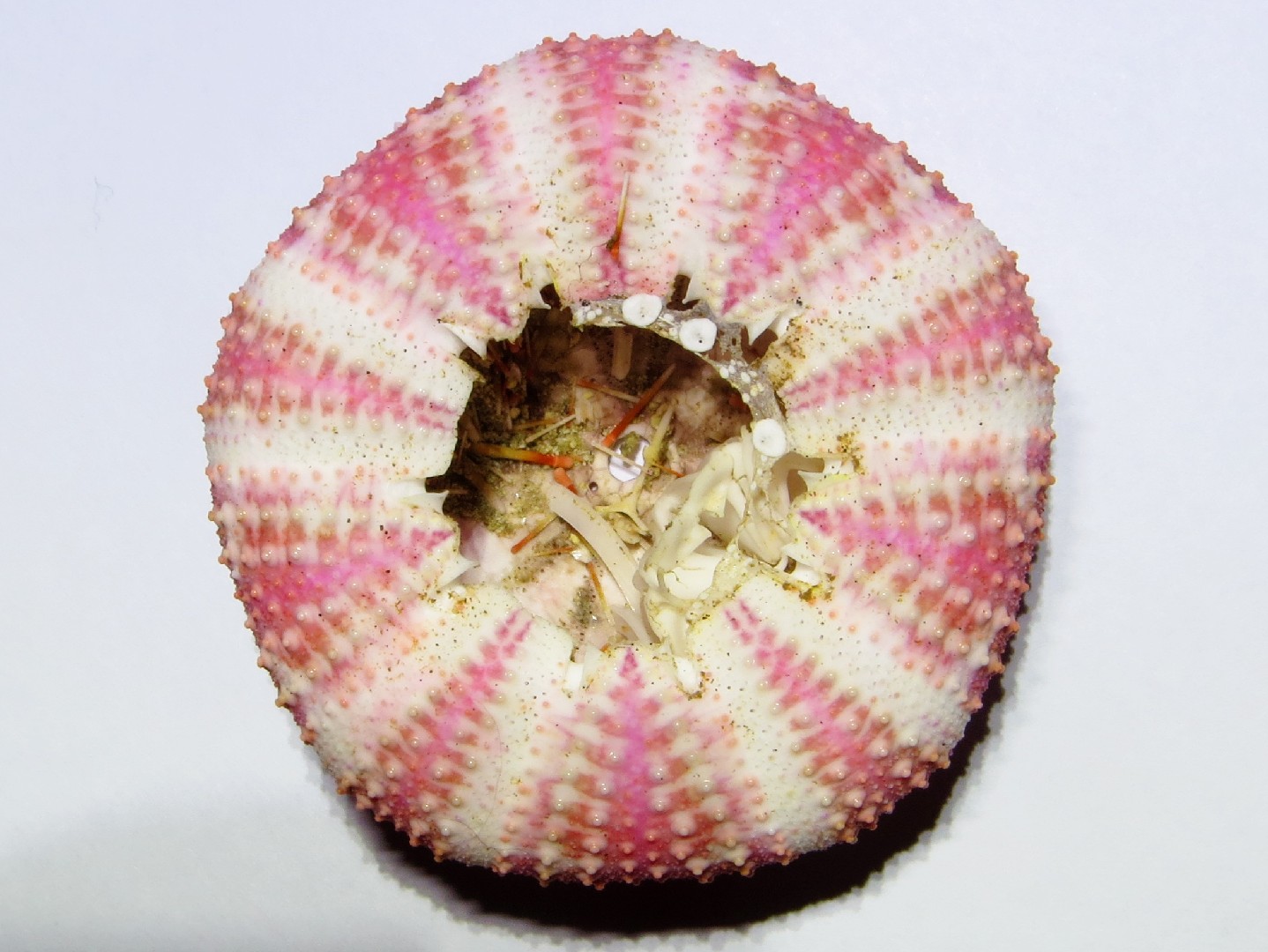Flower urchin
A species of Toxopneustes Scientific name : Toxopneustes pileolus Genus : Toxopneustes
Flower urchin, A species of Toxopneustes
Botanical name: Toxopneustes pileolus
Genus: Toxopneustes
Content
Description People often ask
 Photo By Frédéric Ducarme , used under CC-BY-SA-4.0 /Cropped and compressed from original
Photo By Frédéric Ducarme , used under CC-BY-SA-4.0 /Cropped and compressed from original Description
See also: Sea urchin anatomy Flower urchins are relatively large sea urchins. They can reach a maximum diameter of around 15 to 20 cm (6 to 8 in). Bottom (oral) surface of the flower urchin showing spines, tube feet, and the mouth with the chewing apparatus (Aristotle's lantern) Like most echinoderms, the body of adult flower urchins is equally divided into identical segments around a central axis in multiples of five (pentaradial symmetry). The rigid "shell" (test) has five interambulacral segments separated from each other by five ambulacral segments, each of them are composed of smaller regularly interlocking plates. It is overlaid by a thin layer of skin in living individuals. The test is variegated in coloration, usually deep red and grey, though there are rare instances of green and pale purple. Each ambulacral segment is ornamented by a large purple zigzag pattern running along its length. Two rows of tube feet emerge from the grooves on either side of each of the ambulacral segments (for a total of ten rows). The tube feet are individually composed of a thin muscular stalk (podia) tipped with a small suction cup (ampulla). The mouth is centrally located in the bottom (oral) surface of the test. It is surrounded by a ring of small plates overlaid by softer tissue known as the peristome. Embedded in the peristome are five calcareous "teeth" collectively known as Aristotle's lantern. These are used for grinding the flower urchin's food. The anus is situated on the upper (aboral) surface of the test, directly opposite the mouth. Like the mouth, it is surrounded by a ring of small plates known as the periproct. Surrounding the anal opening are five smaller holes (the genital pores) which are directly connected to the gonads inside the body cavity. The most conspicuous feature of flower urchins are their pedicellariae (stalked grasping appendages). Flower urchins possess four types of pedicellariae, distinguished by form and function, but only two are abundant. The first type are the ophicephalous pedicellariae. They resemble tube feet, except they end in three small claws (called valves) rather than suction cups. These are used to keep the body surface clear of algae, encrusting organisms, and unwanted debris. Illustration of a valve showing the sharp fang-like tip. Three of these form the claw-like ends of the flower urchin globiferous pedicellariae. The second type are the globiferous pedicellariae which superficially resemble flowers (hence its common name). These are more specialized and are used for defense against predators and larger ectoparasites. Globiferous pedicellariae also end in a three-valved claw-like grasping appendage, like they do in ophicephalous pedicellariae, but they are much larger. The valves are connected to each other by a distinctive circular membrane around 4 to 5 mm (0.16 to 0.20 in) in diameter. They are pinkish-white to yellowish-white in color with a central purple dot and a bright white rim. Each valve ends in a sharp fang-like tip which is capable of penetrating human skin. The base of the valves also house venom glands. Some authors further subdivide globiferous pedicellariae into two subtypes based on size - the trumpet pedicellariae and the giant pedicellariae. The other two types of pedicellariae - tridentate and triphyllous - are rare or restricted only to certain areas of the test. The relatively blunt spines are quite short and are usually hidden below the flower-like pedicellariae. They can vary from white, pink, yellow, light green, to purple in coloration with lighter-colored tips. Other members of the genus Toxopneustes are similar in appearance and can be mistaken for flower urchins. Toxopneustes roseus can be distinguished by the uniform coloration of their tests of pink, brown, or purple. It is also restricted to the East Pacific and thus aren't found together with flower urchins. Toxopneustes elegans, which is only found around Japan, can be distinguished by the presence of a distinctive dark stripe just below the tips of their spines. Toxopneustes maculatus is a very rare species known only from specimens from Réunion, Christmas Island, and the Palmyra Atoll. It can be distinguished by the bright violet coloration on the bottom and in a band around the middle of their tests.
* Disclaimer: The judgment on toxicity and danger is for reference only. We DO NOT GUARANTEE any accuracy of such judgment. Therefore, you SHALL NOT rely on such judgment. It is IMPORTANT TO SEEK PROFESSIONAL ADVICE in advance when necessary.
People often ask
Where are flower urchin found?
What does flower urchin eat?
How big does flower urchin get?
What eats a flower urchin?
Scientific Classification
Phylum
Echinoderms Class
Sea urchins Order
Camarodonta Family
Toxopneustidae Genus
Toxopneustes Species
Flower urchin